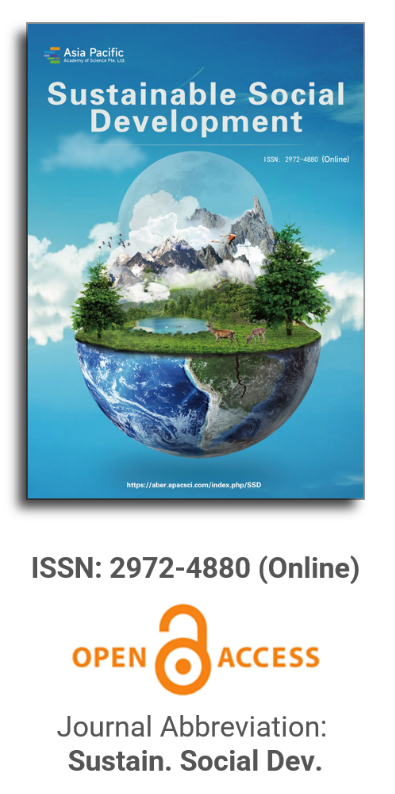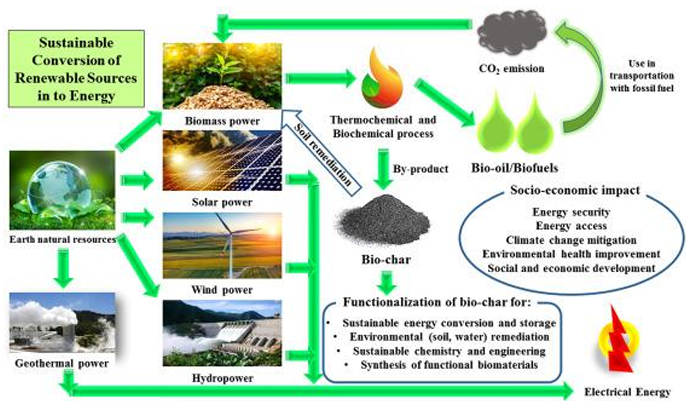
Publication Frequency
Bi-monthly (since 2024)
Journal Articles
Search
Search scope
Journal Center
Asia Pacific Academy of Science Pte. Ltd. (APACSCI) specializes in international journal publishing. APACSCI adopts the open access publishing model and provides an important communication bridge for academic groups whose interest fields include engineering, technology, medicine, computer, mathematics, agriculture and forestry, and environment.
Volume Arrangement
2025
Featured Articles

Coordinated actions to protect biodiversity, incorporate renewable energy, and implement climate action are needed for sustainable development to be achieved in the context of global challenges like climate change, ecosystem destruction, and resource depletion. Climate action seeks to reduce the negative impact and strengthen the adaptive capacity of natural and human society. Climate action includes both adaptation and mitigation strategies. The transition to renewable power sources is of utmost importance to climate action because it helps to slow environmental degradation, curtail fossil fuel dependence, and significantly diminish greenhouse gas emissions. The adoption of renewable energy, such as solar, wind, and hydropower, is more environmentally friendly than conventional energy sources, but it may also pose potential risks towards biodiversity, so measures should be taken in planning to avoid negative environmental impacts. It is crucial to protect biodiversity around the world because it plays an important role in the delivery of ecosystem services such as soil fertility, pollination, water purification, and the sequestration of carbon that are vital to people’s existence. In addition, strong ecosystems reduce the severity of climate change impacts, such as storms, droughts, and flooding. However, there may be trade-offs when striving for the increase of renewable energy and biodiversity conservation. Renewable energy development should always be complemented with biodiversity protection. This approach preserves the environmentally delicate ecosystems that are crucial to achieving climate action targets. The combination of climate action, renewable energy, and the need for biodiversity makes it possible to reap many benefits. These include stronger ecosystems and better human health, as well as economic growth and job creation. One example of such a nature-based solution is agrovoltaics, which combines solar energy production and farming. Restoring ecosystems, like forests or wetlands, can also greatly enhance carbon sequestration, reduce global warming, and protect endangered wildlife. This strategy aligns with international initiatives such as the United Nations Sustainable Development Goals (UN SDGs), specifically SDGs 7, 13, and 15. It serves as a building block towards a more sustainable future. Despite the clear possibilities of synergy, there are still barriers that must be tackled. Policy fragmentation, resource competition, and lack of inter-sector cooperation are some of the challenges that inhibit effective integration. Therefore, equitable governance and the adoption of nature-based techniques are essential.
Evaluating multidimensional energy poverty of South Asian countries: An in-depth analysis using household surveys
Article ID: 3154
Vol 3, Issue 1, 2025
DOI: https://doi.org/10.54517/ssd3154
Vol 3, Issue 1, 2025
Received: 12 December 2024; Accepted: 16 February 2025; Available online: 27 February 2025; Issue release: 28 February 2025
Download PDF
Abstract
This study examines the multidimensional energy poverty index (MEPI), headcount ratio, and intensity in six South Asian countries. Using two datasets (India, 2005 and 2015), (Bangladesh, 2011 and 2017), (Afghanistan, 2010 and 2015), (Pakistan, 2012 and 2017), (Nepal, 2011 and 2016), and (the Maldives, 2009 and 2016), this study employs an adjusted MEPI to compare each country’s effort in multidimensional energy poverty reduction (2005 to 2017). The empirical results indicate that India, Bangladesh, Pakistan, Nepal, and the Maldives significantly reduced MEPI, headcount ratio, and intensity compared to past years. However, in the case of Afghanistan, MEPI and the headcount ratio increased. The empirical results further indicate that although there has been a significant reduction in MEPI, the deprivation of modern cooking fuel and access to electricity remains high in India, Bangladesh, Pakistan, and Nepal. The study invites attention towards clean energy sources and proposes that if these countries provide modern energy fuel to households, a significant reduction is possible in the MEPI score. In our study, the results obtained with modern cooking fuel significantly dropped MEPI, headcount ratio, and intensity. These findings explain the necessary attention toward multidimensional energy poverty reduction strategies in South Asia and other developing countries.
Keywords
multidimensional energy poverty; multidimensional energy poverty reduction; multidimensional energy poverty index; South Asia; policy implications
References
- Jaber MM. Multidimensional energy poverty in Jordan between 2009 and 2018: Progress and possible policy interventions. Regional Statistics. 2023; 13(3): 434-450. doi: 10.15196/rs130303
- White H. Global poverty reduction: are we heading in the right direction? J Int Dev J Dev Stud Assoc. 1999; 11: 503-19. doi: 10.1002/(SICI)1099-1328(199906)11:4<503::AID-JID608>3.0.CO;2-O
- Nussbaumer P, Bazilian M, Modi V. Measuring energy poverty: Focusing on what matters. Renewable and Sustainable Energy Reviews. 2012; 16(1): 231-243. doi: 10.1016/j.rser.2011.07.150
- Mendoza CB, Cayonte DDD, Leabres MS, et al. Understanding multidimensional energy poverty in the Philippines. Energy Policy. 2019; 133: 110886. doi: 10.1016/j.enpol.2019.110886
- Abbas K, Butt KM, Xu D, et al. Measurements and determinants of extreme multidimensional energy poverty using machine learning. Energy. 2022; 251: 123977. doi: 10.1016/j.energy.2022.123977
- The International Trade Administration. Energy Resource Guide - Pakistan - Renewable Energy 2020. Available online: https://www.trade.gov/energy-resource-guide-pakistan-renewable-energy#:~:text=According to National Electric Power Regulatory Authority’s %28NEPRA%29,%28wind%2C solar and bagasse%29 and 4%25 from nuclear (accessed on 10 November 2024).
- Zhang Z, Shu H, Yi H, et al. Household multidimensional energy poverty and its impacts on physical and mental health. Energy Policy. 2021; 156: 112381. doi: 10.1016/j.enpol.2021.112381
- Utami CN, Hartono D. A multidimensional energy poverty in Indonesia and its impact on health. Int Energy J. 2022; 22: 147-56.
- Sadath AC, Acharya RH. Assessing the extent and intensity of energy poverty using Multidimensional Energy Poverty Index: Empirical evidence from households in India. Energy Policy. 2017; 102: 540-550. doi: 10.1016/j.enpol.2016.12.056
- Ahmed M, Zhang X, Shen Y, et al. A deep transfer learning based convolution neural network framework for air temperature classification using human clothing images. Scientific Reports. 2024; 14(1). doi: 10.1038/s41598-024-80657-y
- Jaber MM, Szép T. Subjective indicators of fuel poverty in Zarqa Governorate, Jordan. Energy Efficiency. 2024; 17(3). doi: 10.1007/s12053-024-10197-x
- Jaber MM, Szép T. The Role of Energy in Human Well-being: A Case from Jordan. Green Management: A New Paradigm in the World of Business. 2024; 137-156. doi: 10.1108/978-1-83797-442-920241009
- Agba DZ, Adewara SO, Adama JI, et al. Analysis of the Effects of Climate Change on Crop Output in Nigeria. American Journal of Climate Change. 2017; 06(03): 554-571. doi: 10.4236/ajcc.2017.63028
- World Bank. Who is poor in Pakistan today? Raising the basic standard of well-being in a changing society. World Bank; 2016.
- WHO. Household air pollution and health, 2018. Available online: https://www.who.int/news-room/fact-sheets/detail/household-air-pollution-and-health (accessed on 10 November 2024).
- Day R, Walker G, Simcock N. Conceptualising energy use and energy poverty using a capabilities framework. Energy Policy. 2016; 93: 255-264. doi: 10.1016/j.enpol.2016.03.019
- Crentsil AO, Asuman D, Fenny AP. Assessing the determinants and drivers of multidimensional energy poverty in Ghana. Energy Policy. 2019; 133: 110884. doi: 10.1016/j.enpol.2019.110884
- Sule IK, Yusuf AM, Salihu MK. Impact of energy poverty on education inequality and infant mortality in some selected African countries. Energy Nexus. 2022; 5: 100034. doi: 10.1016/j.nexus.2021.100034
- Hosan S, Rahman MM, Karmaker SC, et al. Remittances and multidimensional energy poverty: Evidence from a household survey in Bangladesh. Energy. 2023; 262: 125326. doi: 10.1016/j.energy.2022.125326
- Chen H, Gao K, Tian S, et al. Nexus between energy poverty and sustainable energy technologies: A roadmap towards environmental sustainability. Sustainable Energy Technologies and Assessments. 2023; 56: 102949. doi: 10.1016/j.seta.2022.102949
- Khan Z, Haouas I, Trinh HH, et al. Financial inclusion and energy poverty nexus in the era of globalization: Role of composite risk index and energy investment in emerging economies. Renewable Energy. 2023; 204: 382-399. doi: 10.1016/j.renene.2022.12.122
- Sovacool BK. The political economy of energy poverty: A review of key challenges. Energy for Sustainable Development. 2012; 16(3): 272-282. doi: 10.1016/j.esd.2012.05.006
- Ahmed M, Shuai C, Abbas K, et al. Investigating health impacts of household air pollution on woman’s pregnancy and sterilization: Empirical evidence from Pakistan, India, and Bangladesh. Energy. 2022; 247: 123562. doi: 10.1016/j.energy.2022.123562
- Ahmed M, Shuai C, Ahmed M. Influencing factors of carbon emissions and their trends in China and India: a machine learning method. Environmental Science and Pollution Research. 2022; 29(32): 48424-48437. doi: 10.1007/s11356-022-18711-3
- Amin A, Liu Y, Yu J, et al. How does energy poverty affect economic development? A panel data analysis of South Asian countries. Environmental Science and Pollution Research. 2020; 27(25): 31623-31635. doi: 10.1007/s11356-020-09173-6
- Ekholm T, Krey V, Pachauri S, et al. Determinants of household energy consumption in India. Energy Policy. 2010; 38(10): 5696-5707. doi: 10.1016/j.enpol.2010.05.017
- Liddell C, Guiney C. Living in a cold and damp home: frameworks for understanding impacts on mental well-being. Public Health. 2015; 129(3): 191-199. doi: 10.1016/j.puhe.2014.11.007
- Grey CNB, Jiang S, Nascimento C, et al. The short-term health and psychosocial impacts of domestic energy efficiency investments in low-income areas: a controlled before and after study. BMC Public Health. 2017; 17(1). doi: 10.1186/s12889-017-4075-4
- Abbas K, Zou S, Xu D, et al. Forecasting synergistic pathways between rare earth elements, renewable energy, and product and economic complexities in achieving a low-carbon future. Journal of Environmental Management. 2024; 365: 121578. doi: 10.1016/j.jenvman.2024.121578
- Administration IT. Energy Resource Guide - Pakistan - Renewable Energy 2021. Available online: https://www.trade.gov/energy-resource-guide-pakistan-renewable-energy#:~:text=According to National Electric Power Regulatory Authority’s %28NEPRA%29,%28wind%2C solar and bagasse%29 and 4%25 from nuclear (accessed on 10 November 2024).
- Urpelainen J. Energy poverty and perceptions of solar power in marginalized communities: Survey evidence from Uttar Pradesh, India. Renew Energy. 2016; 85:534–539. doi: 10.1016/j.renene.2015.07.001
- Islar M, Brogaard S, Lemberg-Pedersen M. Feasibility of energy justice: Exploring national and local efforts for energy development in Nepal. Energy Policy. 2017; 105: 668-676. doi: 10.1016/j.enpol.2017.03.004
- Abbas K, Xie X, Xu D, et al. Assessing an empirical relationship between energy poverty and domestic health issues: A multidimensional approach. Energy. 2021; 221: 119774. doi: 10.1016/j.energy.2021.119774
- Jahangiri M, Haghani A, Mostafaeipour A, et al. Assessment of solar-wind power plants in Afghanistan: A review. Renewable and Sustainable Energy Reviews. 2019; 99: 169-190. doi: 10.1016/j.rser.2018.10.003
- Wu B, Liu S, Wang J, et al. Assessing the mechanism of energy efficiency and energy poverty alleviation based on environmental regulation policy measures. Environmental Science and Pollution Research. 2021; 28(30): 40858-40870. doi: 10.1007/s11356-021-13605-2
- Abbas K, Xu D, Li S, et al. Health implications of household multidimensional energy poverty for women: A structural equation modeling technique. Energy and Buildings. 2021; 234: 110661. doi: 10.1016/j.enbuild.2020.110661
- Dekanozishvili M. Dynamics of EU Renewable Energy Policy Integration. Springer International Publishing; 2023.
- Govindan K. Pathways to low carbon energy transition through multi criteria assessment of offshore wind energy barriers. Technological Forecasting and Social Change. 2023; 187: 122131. doi: 10.1016/j.techfore.2022.122131
- Li S, Samour A, Irfan M, et al. Role of renewable energy and fiscal policy on trade adjusted carbon emissions: Evaluating the role of environmental policy stringency. Renewable Energy. 2023; 205: 156-165. doi: 10.1016/j.renene.2023.01.047
- Mishra P, Behera B. Socio-economic and environmental implications of solar electrification: Experience of rural Odisha. Renewable and Sustainable Energy Reviews. 2016; 56: 953-964. doi: 10.1016/j.rser.2015.11.075
- Dartanto T, Nurkholis. The determinants of poverty dynamics in Indonesia: evidence from panel data. Bulletin of Indonesian Economic Studies. 2013; 49(1): 61-84. doi: 10.1080/00074918.2013.772939
- Khandker SR, Samad HA, Ali R, et al. Who Benefits Most from Rural Electrification? Evidence in India. The Energy Journal. 2014; 35(2): 75-96. doi: 10.5547/01956574.35.2.4
- Adusah-Poku F, Takeuchi K. Energy poverty in Ghana: Any progress so far? Renewable and Sustainable Energy Reviews. 2019; 112: 853-864. doi: 10.1016/j.rser.2019.06.038
- Andadari RK, Mulder P, Rietveld P. Energy poverty reduction by fuel switching. Impact evaluation of the LPG conversion program in Indonesia. Energy Policy. 2014; 66: 436-449. doi: 10.1016/j.enpol.2013.11.021
- Wirawan H, Gultom YML. The effects of renewable energy-based village grid electrification on poverty reduction in remote areas: The case of Indonesia. Energy for Sustainable Development. 2021; 62: 186-194. doi: 10.1016/j.esd.2021.04.006
- Park MY, Shin S, Kim ES. Effective energy management by combining gas turbine cycles and forward osmosis desalination process. Applied Energy. 2015; 154: 51-61. doi: 10.1016/j.apenergy.2015.04.119
- Nadimi R, Tokimatsu K, Yoshikawa K. Sustainable energy policy options in the presence of quality of life, poverty, and CO 2 emission. Energy Procedia. 2017; 142: 2959-2964. doi: 10.1016/j.egypro.2017.12.314
- Nadimi R, Tokimatsu K. Energy use analysis in the presence of quality of life, poverty, health, and carbon dioxide emissions. Energy. 2018; 153: 671-684. doi: 10.1016/j.energy.2018.03.150
- Nazif-Muñoz JI, Spengler JD, Arku RE, et al. Solid fuel use and early child development disparities in Ghana: analyses by gender and urbanicity. Journal of Exposure Science & Environmental Epidemiology. 2020; 30(4): 698-706. doi: 10.1038/s41370-020-0224-4
- Acharya RH, Sadath AC. Energy poverty and economic development: Household-level evidence from India. Energy and Buildings. 2019; 183: 785-791. doi: 10.1016/j.enbuild.2018.11.047
- Hartono D, Hastuti SH, Balya AA, et al. Modern energy consumption in Indonesia: Assessment for accessibility and affordability. Energy for Sustainable Development. 2020; 57: 57-68. doi: 10.1016/j.esd.2020.05.002
- Pallegedara A, Mottaleb KA, Rahut DB. Exploring choice and expenditure on energy for domestic works by the Sri Lankan households: Implications for policy. Energy. 2021; 222: 119899. doi: 10.1016/j.energy.2021.119899
- Mahmood R, Shah A. Deprivation Counts: An Assessment of Energy Poverty in Pakistan. THE LAHORE JOURNAL OF ECONOMICS. 2017; 22(1): 109-132. doi: 10.35536/lje.2017.v22.i1.a6
- Alkire S, Foster J. Understandings and misunderstandings of multidimensional poverty measurement. The Journal of Economic Inequality. 2011; 9(2): 289-314. doi: 10.1007/s10888-011-9181-4
- Alkire S, Apablaza M. Multidimensional poverty in Europe 2006-2012: Illustrating a methodology. Oxford Poverty Hum Dev Initiat Work Pap; 2016.
- OECD. India 2020 Energy Policy Review 2020. Available online: https://www.oecd.org/india/india-2020-9faa9816-en.htm (accessed on 10 November 2024).
- GC DB, Cheng S, Bhandari J, et al. Multidimensional poverty in Bajhang district of Nepal. Pakistan J Agric Sci. 2015; 52.
Supporting Agencies
Copyright (c) 2025 Author(s)
License URL: https://creativecommons.org/licenses/by/4.0/

This site is licensed under a Creative Commons Attribution 4.0 International License (CC BY 4.0).
Editor-in-Chief

Prof. Kittisak Jermsittiparsert
University of City Island, Cyprus
Indexing & Archiving






News & Announcements
2025-11-10
SSD Has Been Accepted for Inclusion in Scopus!
We are delighted to share the excellent news that our journal Sustainable Social Development has officially been accepted for inclusion in Scopus! This milestone follows the positive evaluation result we received from Scopus on 27 October 2025.
2025-05-19
Cancellation of Forum on Sustainable Social Development & Computing and Artificial Intelligence
It is with deep regret that we announce the cancellation of the Forum on Sustainable Social Development & Computing and Artificial Intelligence, originally scheduled for June 15, 2025.
2024-04-13
New Editorial Board Member: Dr. Jiabo Yin
We are pleased to invite Dr. Jiabo Yin to join the Editorial Board of the journal Sustainable Social Development (eISSN: 2972-4880). This is the second year that Sustainable Social Development has been published. We are confident that the contribution of Dr. Jiabo Yin to the journal will bring new vigor to the study of sustainable development in earth science-related fields.
2024-03-05
Volume 2 Issue 1, 2024 is live
The full issue of Volume 2, Issue 1, 2024 is now available online at here! We are pleased to invite our editorial board member Prof. Francesca Latino to write an editorial on this issue. We sincerely welcome researchers working on sustainable development research to read this issue and draw inspiration from its findings.

